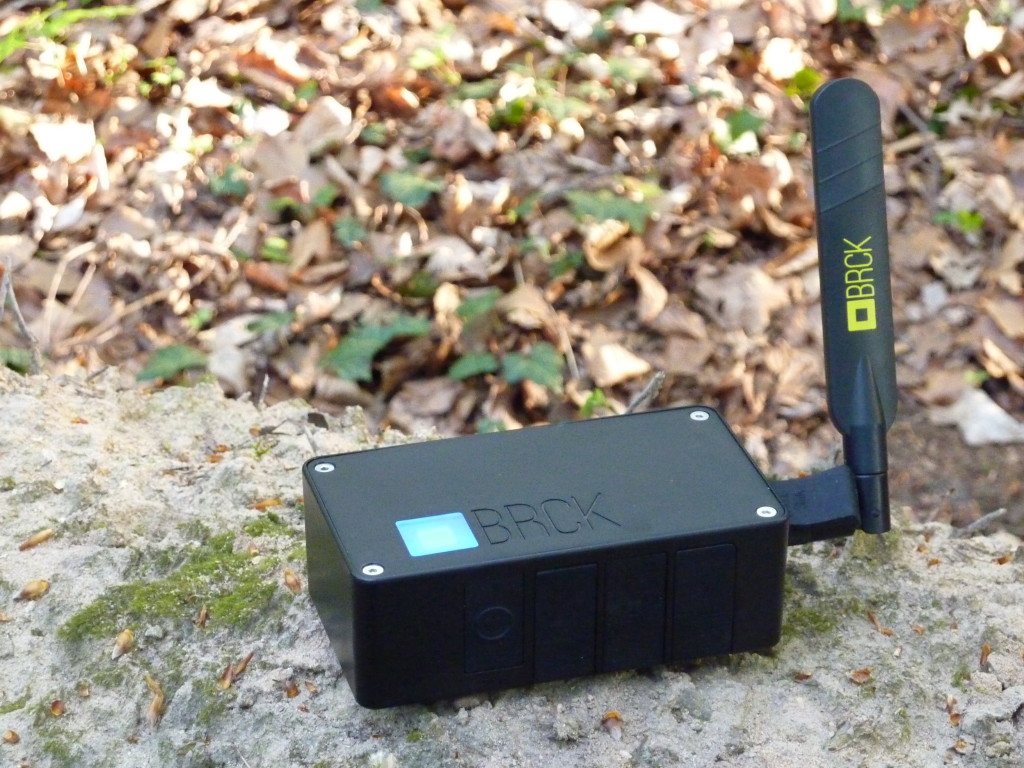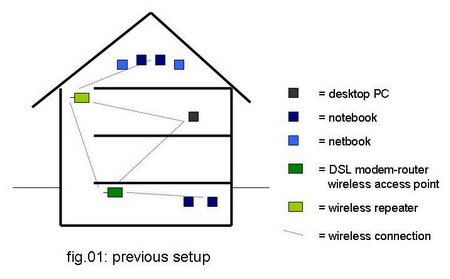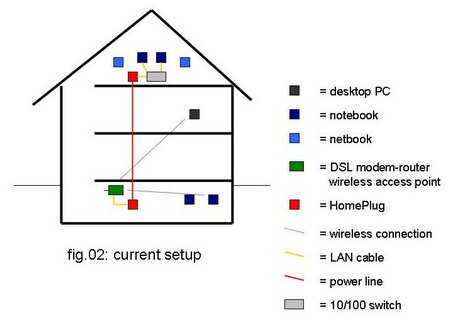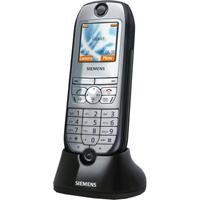Mein alter Schul- und Bloggerfreund Cedric Weber hat sich in den letzten Weihnachtsferien seinen Brck in der Brck-Zentrale in Nairobi (Kenia) abgeholt. Und ich darf den jetzt endlich testen. Yay!

Mein alter Schul- und Bloggerfreund Cedric Weber hat sich in den letzten Weihnachtsferien seinen Brck in der Brck-Zentrale in Nairobi (Kenia) abgeholt. Und ich darf den jetzt endlich testen. Yay!

I never thought this would actually work. But it does.
We currently share a room in this row/town house, right under the roof. The DSL modem that connects this house to the internet is in the basement, and I have in the past used this Edimax router as a repeater for the wireless signal (not WDS-mode!) so that we could also enjoy the connectivity to the internet with our computers upstairs (see fig.01):

There are two floors in between the basement and our “penthouse” flat and the wireless signal would often fail to work, even though the data rate was quite good on the repeater. I think there is a microwave somewhere near our repeater and the base station in the neighbouring house which just jams the signal quality. Both the DSL modem-router-wlan-ap and the repeater upstairs had been tuned with 4dB antennas.
Wireless networks unfortunately tend to have the nasty habbit of interfering each other, especially if there isn’t enough “space” on the frequency range. And then, also, most of these conventional (= IEEE 802.11) wireless networks are still to fragile to deliver consistent data rates. By the time I set this network up in late 2007, most of our neighbours still didn’t have their own WLANetwork, but today most of them have do so it was about time for a change.
 I had read about these “HomePlugs” – the “industry trade group for power line communication” which is a technology that connects LAN devices to each other through the power lines in a home. The manufacturers of these devices claim that it will only work on the same (electrical) phase, and since this house also has an electrical heating system and a second fuse box under the roof (next to the one in the basement), I initially thought it wouldn’t work. But it does!
I had read about these “HomePlugs” – the “industry trade group for power line communication” which is a technology that connects LAN devices to each other through the power lines in a home. The manufacturers of these devices claim that it will only work on the same (electrical) phase, and since this house also has an electrical heating system and a second fuse box under the roof (next to the one in the basement), I initially thought it wouldn’t work. But it does!

Fig.02 shows the current setup using two HomePlugs I’ve bought earlier this week. There are different manufacturers selling kits with two such plugs – mine was relatively cheap – an “MSI ePower 85 Kit Version II“. MSI claims this device to deliver up to 85 Mbps in optimal conditions but the actual rate is around 30 Mbps which is perfectly fine with me as our DSLine currently is around 8Mbps only. It’s also said to have 56bit DES encryption and you can also give it its own network name. The best part is the installation: Just open the box, take a plug and connect a LAN cable to it and the other end of the cable into your LAN device (here: the DSL modem router) and plug it into the next socket (I’ve even used an extension cable which shouldn’t be done but it still works). I then plugged in the other plug to a wall socket upstairs and connected it to an 8-port 10/100 switch which distributes the signal to all four computers as well as a VoIP phone and an HP OfficeJet 7210 network printer. This MSI ePower Kit comes with utility software to set extra parameters such as a network name or the password (which unfortunately only runs on Windows systems), but you won’t have to adjust anything. Just plug it in and you’re done!
I was a bit sceptical if this would work out due to the additional power network in this house + possible intereferences that would spoil the reception of shortware radio (many radio hams actually hate this technology), but it just works like a charm and even my radioscanner hasn’t complained yet.
For anyone who’s been having problems with a wireless network – if the voltage is more or less stable (= probably not in Kenya?), I’d recommend these HomePlug/powerline devices as the perfect alternative to having (longer) LAN cables from one room to the other or even an unstable wireless connection.
 AOB: I’ve once again changed the Feedburner link to my RSS-feed which should now be: http://feeds2.feedburner.com/kikuyumoja . To subscribe to my feed, pls use this new link by either saving it on your RSS reader, or alternatively click on the “subscribe me, baby!” on the top row of this page. Thank you. (thx, @Czed !)
AOB: I’ve once again changed the Feedburner link to my RSS-feed which should now be: http://feeds2.feedburner.com/kikuyumoja . To subscribe to my feed, pls use this new link by either saving it on your RSS reader, or alternatively click on the “subscribe me, baby!” on the top row of this page. Thank you. (thx, @Czed !)
 I am currently looking/searching for a simple cordless VoIP phone that may be used at home and ONLY connects to the local Wi-Fi/WLAN (802.11). Are there any such models on the market? A few, it seems, but still too expensive or with too many extra options.
I am currently looking/searching for a simple cordless VoIP phone that may be used at home and ONLY connects to the local Wi-Fi/WLAN (802.11). Are there any such models on the market? A few, it seems, but still too expensive or with too many extra options.
What I want is to set up different Sipgate.de telephone numbers / VoIP profiles to such a device because the Fritz!Box 7141 DSL modem/router down in the basement only provides output to two analoge phones. And while you can set this advanced and very popular Fritz!Box system to accept more than just one internet VoIP number, one can only connect two physical phones via cable to the box (at least something, right?). These two lines are already blocked by the landlord’s phone + his AIO printer/fax machine. And his internal phone system is also analog and dates back to 1993. I could of course also try to hack the Fritz!Box (which is in fact a full computer and based on a “Linux”-system) and add an AsteriX PBX that takes care of the routing process, but I actually don’t want to change the existing system. And adding another Fritz!Box would provide at least two more “lines” to which I could connect normal wireless phones and define these VoIP profiles right on the Fritz!Box (both boxes connected via WDS). This doesn’t make much sense though, as I’d already bought a simple WLAN AP the other day which acts as a repeater to cover the area under the roof of the house (where I live).
The alternative would be to use a mobile phone like my Nokia N95 which already comes with WLAN/Wi-Fi connectivity and allows for different VoIP profiles to be set up. However, I think that most of these Wi-Fi enabled mobile (GSM) phones only have a very weak antenna and rx/tx ratio, resulting in frequent signal losses unless of course you’re standing next to the access point. Plus, the N95 is a mobile and is with me all the time – while a much simpler Wi-Fi-only cordless phone like the above pictured Siemens SL75 WLAN could remain at home and provide telephony to the home office.
What I really like about VoIP is that you can take your number with you – and as long as customers in Germany often still pay much more to call a mobile line than a fixed line, it’s way smarter to also offer a fixed line number (like the one I was provided by sipgate.de for free some years ago) to your customers.
Again, any advice/comment on this issue is highly appreciated. Thx!
![]() Auf Deutsch: ich suche ein reines Schnurlostelefon, das sich über WLAN mit einem Access Point verbindet und verschiedene VoIP Profile akzeptiert. Irgendwie hat es seit 2006 keine wirkliche Entwicklung auf dem Markt gegeben, aber vielleicht irre ich mich da auch. Eine reine USB-Lösung setzt leider immer einen aktiven Rechner voraus – und da kann man dann genausogut via Headset telefonieren und sich zB den (ebenfalls vorhandenen!) USB Hörer von Sipgate sparen.
Auf Deutsch: ich suche ein reines Schnurlostelefon, das sich über WLAN mit einem Access Point verbindet und verschiedene VoIP Profile akzeptiert. Irgendwie hat es seit 2006 keine wirkliche Entwicklung auf dem Markt gegeben, aber vielleicht irre ich mich da auch. Eine reine USB-Lösung setzt leider immer einen aktiven Rechner voraus – und da kann man dann genausogut via Headset telefonieren und sich zB den (ebenfalls vorhandenen!) USB Hörer von Sipgate sparen.
Über WLAN deswegen, weil die beiden FON 1&2 Leitungen an der Fritz!Box schon belegt sind und eine Erweiterung der Anlage damit nur noch über Funk & VoIP möglich erscheint.
Die Kombination aus WLAN Telefon und 2. access point (der das Signal der Fritz!Box ausm Keller bis unters Dach verstärkt) funktioniert schon mal – nur eben nicht so super, da die Antenne / Funkverbindung im Nokia N95 bauartbedingt schwächer ist als es ein reines WLAN Telefon wie das oben abgebildete Siemens bieten könnte.